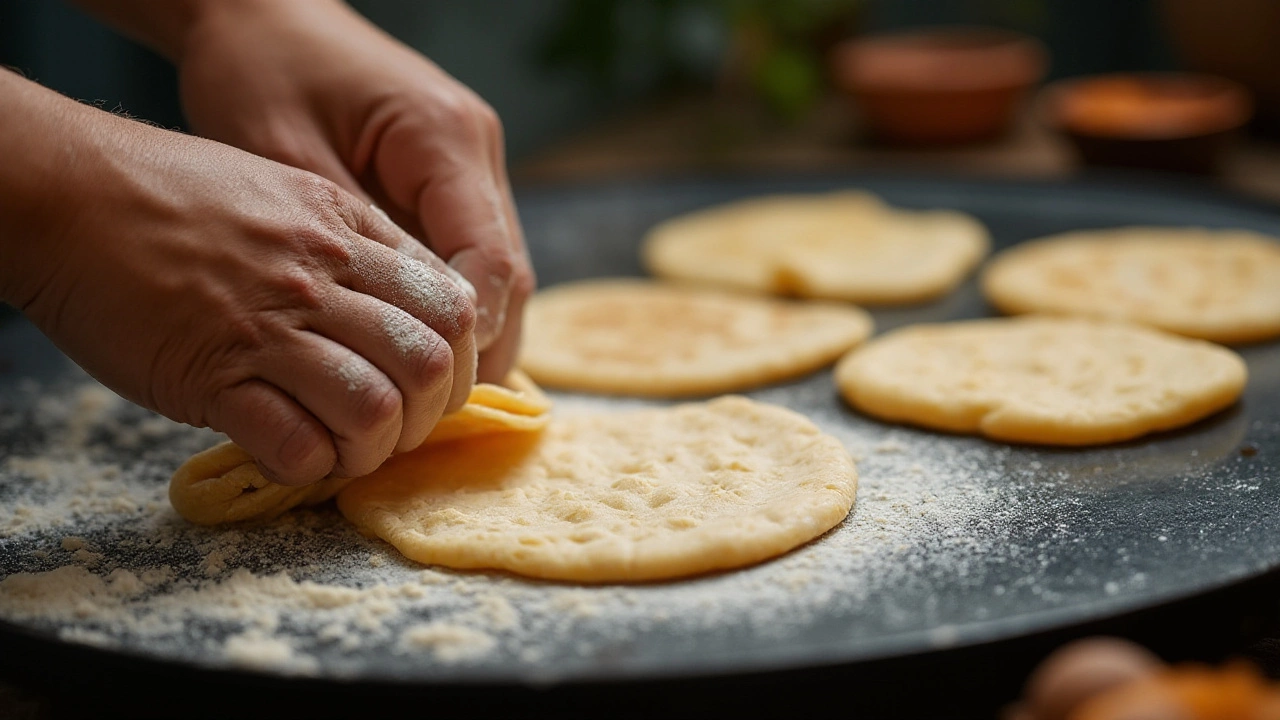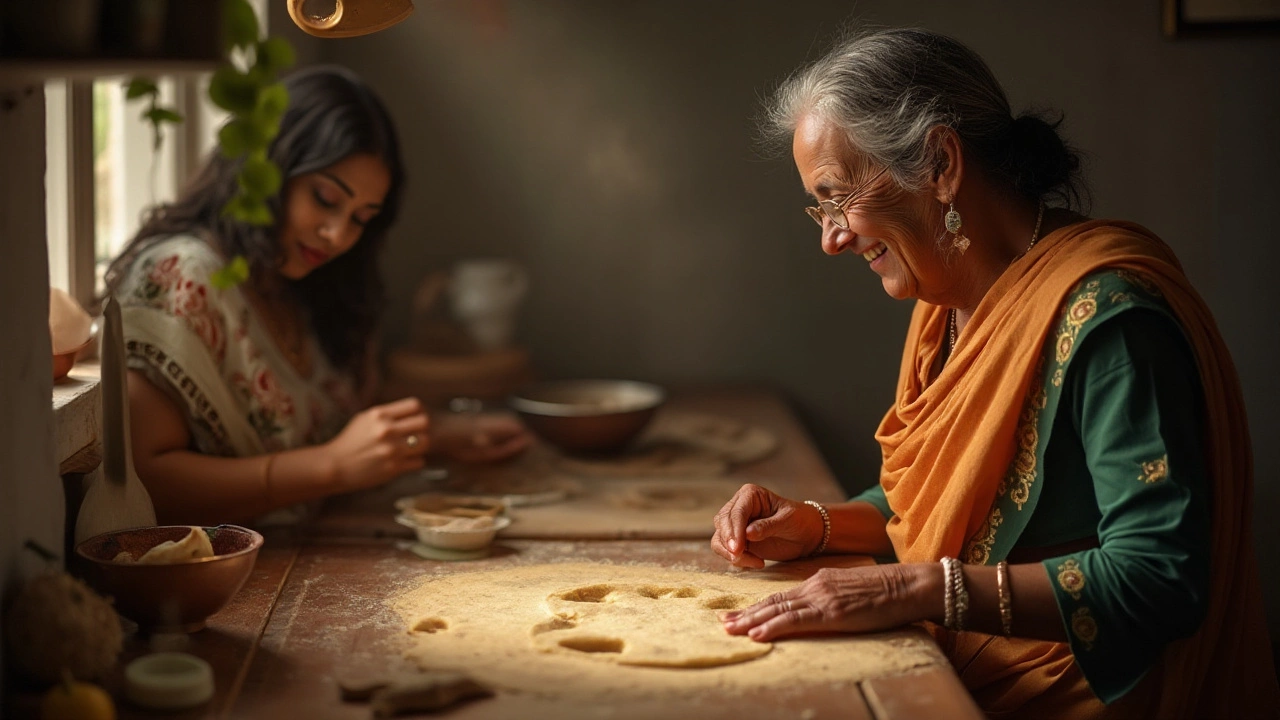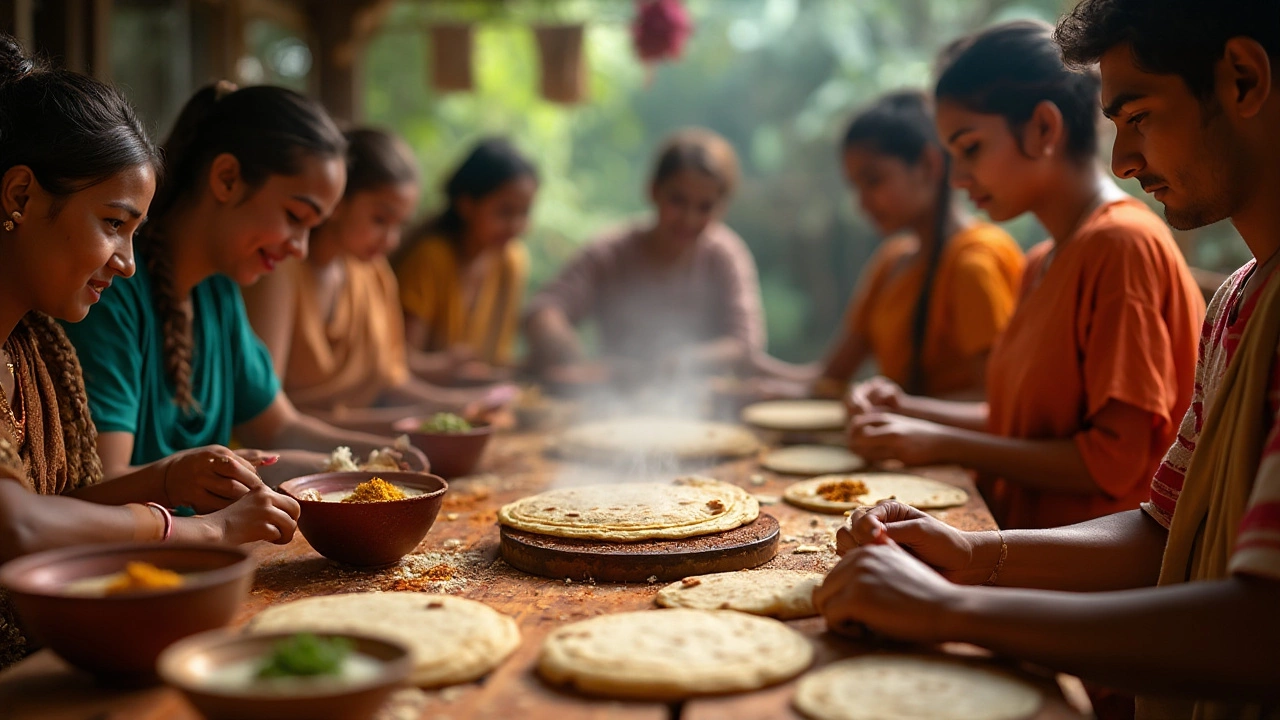17 Nov 2024
- 0 Comments
In the world of cooking, few things spark as much quiet judgment as a roti that doesn't quite hit the mark of circular perfection. It’s tempting to believe that a round roti is the pinnacle of achievement, a sign of a seasoned roti maker. But why does roundness carry such weight? As it turns out, there is more to this simple flatbread than just its shape.
The tradition of making rotis as round as the moon has its roots in visual appeal and cultural significance, but at its heart, a roti is about nourishment and connection. It's the taste, texture, and the love kneaded into the dough that truly define this beloved staple.
Embracing both expert and novice narratives, this exploration delves into the realm where imperfections create uniqueness. We'll share tips that focus on the quality of the dough and cooking techniques that enhance your roti-making skills beyond mere aesthetics, encouraging cooks to celebrate their culinary individuality.
- The Tradition of Round Rotis
- Textural Tales: What Really Matters
- Practical Tips for Roti Perfection
- Embracing Imperfection in the Kitchen
- Cultural Variances and Modern Adaptations
The Tradition of Round Rotis
The pursuit of the perfectly round roti is a tale as old as time in many households, stretching across diverse cultures and generations. In many South Asian families, crafting a round roti is often seen as a rite of passage into culinary adulthood. The circular shape is not simply an aesthetic preference; it carries layers of tradition, symbolism, and practicality. Historically, the form was ideal for cooking on a flat tawa, ensuring even heat distribution. This practical need became intertwined with cultural measures of skill, where a round roti showcased a cook's finesse and expertise.
Round rotis have long been a symbol of nurturance and love, hand-prepared by mothers and grandmothers as an essential part of daily meals. The round form offers more than just pragmatic cooking benefits; it can represent completeness and unity in Indian cultural iconography, which perhaps elevates its importance in the context of daily sustenance. In gatherings, presenting a stack of perfect rotis often signifies hospitality and care. Though the skill of making uniform, round rotis can seem intimidating to novices, the tradition endures as a cherished skill, passed down with pride.
Many respected cooks and food writers have shared their insights on the enduring appeal of the round roti. According to acclaimed food writer Tarla Dalal, "the art of making a round roti is not just in the rolling but in the practice, patience, and the love behind each effort." This perspective reinforces the idea that achieving a round shape isn't simply about precision, but about the history and affection it embodies. Delving into roti-making forums, you’ll find stories of mistakes turned into victories, emphasizing the human connection behind this ancient tradition.
Throughout the regions where roti is a staple, variations exist, both in recipe and form, hinting at the evolutionary nature of culinary practices. As families incorporate modern tools like dough-rolling machines, the art remains unchanged at its core: creating sustenance with heart and heritage. While the quest for the perfect circle may continue informally, the evolution of roti shapes is a testament to the adaptability and resilience of this culinary tradition, proving that taste presides over precision.
Textural Tales: What Really Matters
While the obsession with a round roti might seem universal, the essence of this beloved bread has little to do with its shape. Instead, what truly matters is the texture, which embodies the care and technique involved in its making. The ideal roti is soft, pliable, and full of character — qualities not dictated by its form but by the grain of the wheat, the humidity in the air, and the gentle coaxing of a practiced hand. Often overlooked, these textural nuances define the culinary experience. Rotis are not merely about appearance but an invitation to savor a rich tapestry of aromatic flavors that emerge during the cooking process.
Every home cook has a tale to tell, laden with the aroma of fresh flour mingling with that of a hot tava. The flour's quality is paramount; whole wheat flour, rich and somewhat gritty compared to its finely milled counterparts, serves as the foundation for a good roti. Balancing the water-to-flour ratio is an art form in itself, where the end goal is a dough that yields tender rotis with just enough chew. The kneading process, too, has its own story—a ritual that imbues the dough with a suppleness that speaks to the live-in-the-moment wisdom of generations past.
"Cooking is not about convenience, and it's not about shortcuts. Our humanity is not in the machines, but in us. The point of food is that we get to share time and space." — Patriarch of Food, David Chang.
Despite the pressure for visual uniformity, the cooking process demands a dance-like rhythm, often dictated by the temperament of the dough. Some cooks lightly sprinkle the surface with flour as the roti rolls out, a gentle, tactile motion reminding them of family collectives and cooking stories shared through laughter. Balancing heat on a tava adds another layer of skill, ensuring the roti balloons and browns beautifully—its soft parts crumbling under gentle fingers to reveal layers that tell a tale of heat and gentleness. The mouthfeel reinforces the experience—a softened canvas that complements the spices and flavors of accompanying dishes without overpowering them.
Texture, the Unsung Hero
Exploring the secrets locked within the texture reveals why roti making tips emphasize ingredients' handling over their symmetry. An authentic roti, supple and flavorful, acts as a vessel for the tastes it accompanies, capturing the essence of tradition. True mastery lies not in achieving a perfectly round roti but in engaging with its liveliness—understanding how flour's gluten structure balances with water and how the choreography of heat and flip affects its hospitable personality.
The personal touch cannot be undervalued, as observed in many kitchens where a touch of ghee right before the finish lends the bread a glow and a savory pop. Eventually, taste takes precedence, and when you find ways to perfect the texture, you'll realize the form's limits are just part of its story, an aspect that enriches but does not define. The journey of texture over the obsession for a flawless shape tells us rotis are as much about embracing imperfection as perfecting craft, a testament to the resilience and adaptability inherent in culinary traditions worldwide.

Practical Tips for Roti Perfection
Making the perfect roti goes beyond achieving that elusive roundness. When you dive deeper into the essence of this beloved bread, you realize that the quest for roundness is merely the beginning. The true art of roti making lies in a combination of the right ingredients, technique, and experience. To start, ensuring the quality of your flour is crucial. Choose whole wheat flour that feels smooth to the touch; it is the foundation of texture and flavor in your roti. The freshness of the flour guarantees that your dough won't taste stale, providing a base that is both firm and flexible.
The next step in achieving roti perfection is nailing the dough consistency. Mixing flour with warm water, gradually, is a technique that might seem simplistic, yet it's pivotal. As you blend, keep the mixture slightly sticky but not too wet. Knead the dough for at least 5 to 10 minutes until it becomes elastic and smooth. A well-kneaded dough traps air which aids in making the roti puff beautifully, which is one of the hallmarks of a well-cooked roti. Many also suggest resting the dough for about 30 minutes to let the gluten relax. This resting period helps in rolling the roti with ease and ensures that it cooks evenly.
A crucial, yet underrated, tip is to maintain your rolling pin and surface as dust-free as possible using just a light sprinkling of flour. Too much flour on the rolling board can make the roti dry and hard. Roll from the center outwards, applying even pressure; this is where many cooks find their rhythm. This might require practice, but every failed attempt adds to the experience. The goal is a uniform thickness, so our roti cooks evenly without leaving any parts raw or overdone.
Now, let's talk about the actual cooking process. Heat your tawa or griddle on medium heat before placing the rolled-out roti. You might be tempted to apply high heat, but it’s a gentle journey that a roti appreciates. Cooking the roti for about 30 seconds on one side until you see small bubbles forming, then flipping, creates an ideal texture. Once flipped, you can press gently around the edges to help it puff. Finally, the secret to that soft, sumptuous roti is a drizzle of ghee or oil right after cooking, sealing in moisture and flavor.
Innovation in traditional cooking methods can lead to unexpected results. Renowned chef Sanjeev Kapoor once mentioned, "The secret ingredient to perfect roti is patience." His quote reminds us that while tips and techniques are important, giving yourself the grace and patience to learn and improve progressively is equally essential. Over time, these practices become second nature, allowing you to improvise and perfect your rotis, irrespective of their shape.
Embracing Imperfection in the Kitchen
When it comes to making a round roti, many of us have been conditioned to view a perfectly circular shape as the ultimate proof of success. This stringent standard often turns the gentle art of roti-making into a stressful endeavor, leading many to shun the spatula in fear of critique. But why do we chase this flawless roundness so fervently? Cooking, at its essence, is an expression of creativity and personal touch. The truth is, the world of food is beautifully imperfect, and rotis are certainly no exception. Each batch tells a story—size, shape, and unevenness included.
Embracing imperfection in this daily ritual can be liberating. Almost every home cook has a tale of that odd-shaped roti, met with laughter and shared between bites. And in that moment, the focus on enjoying the meal becomes more important than the relentless pursuit of faultlessness. The joy of cooking sprouts not from standards upheld by generations, but from a genuine appreciation for the food that nourishes us. There's wisdom in choosing substance over form, acknowledging that a slightly misshapen roti can taste just as heavenly.
“Imperfection is a form of freedom,” said the writer Anh Dao Pham, capturing succinctly how liberating it can be to accept the natural flaws in our creations. Such acceptance can transform kitchen time into a joyous experience rather than a source of stress.Mistakes evolve into lessons rather than failures, offering insights into adjusting heat, dough consistency, or kneading techniques. These are discoveries that perfect rounds often miss in their robotic precision.
Let us not forget the influence of modern culinary innovators who embrace imperfections with much regard. Social media, flooded with images and stories of uniquely shaped rotis that defy tradition yet fill bellies with hearty delight, highlight a growing shift in perception. Evidently, authenticity has claimed a seat at the dinner table, sparking conversations that bridge cultures and cuisines. In this age, a focus on the taste and texture of non-round roti takes precedence, encouraging creativity over conformity.
For those embarking on a journey of roti-making or any culinary path, remember that a meal shared is a moment cherished, whether served on a silver platter or a kitchen counter. In the embrace of imperfection, we find the freedom to be ourselves, celebrated in kitchens across the world. And isn’t that what truly makes cooking a universally beloved endeavor?

Cultural Variances and Modern Adaptations
The simple magic of a roti, its aroma, and warmth are universal, yet the journey of this flatbread across cultures and its various adaptations highlight its unique versatility. In India, where the round roti has its origin, it stands as a staple. The effort towards achieving that perfect circle is both a rite of passage and a testament to culinary prowess. Mother to daughter, this skill is passed down, with the roundness symbolizing both skill and tradition. Even small regional changes introduce new flavors and methods - from using ghee instead of oil to employing clay stoves for extra smoky notes.
Moving westward to the Middle East, flatbreads reflect a glorious history intertwined with trade routes and ancient traditions. In Turkey, the lavas, akin to roti, is puffed and soft, expanding to accommodate different fillings, symbolizing communal eating. Meanwhile, in Iran, you'd find the thinner lavash, a cousin to the roti. Such slight variations exhibit cultural nuances, where the roti shape might adjust ever so slightly to fit local cooking conditions and dining rituals.
Modern times have redefined roti. As globalization brings new needs, recipes adapt. Gluten-free and whole grain alternatives are cropping up in households worldwide, meeting the demands of varied dietary preferences. Kitchens see the embrace of technology, with nifty gadgets promising the perfect round roti at the push of a button. Despite such innovations, many find joy in the tactile connection of rolling dough by hand and the comforting aromas rising from stovetops.
Here's an interesting observation: in many cities across Europe and the United States, trendy eateries have started serving ginormous wraps using roti or its spin-offs. These wraps flaunt global flavors, from spicy chickpea curries to Caribbean jerk chicken. It's a transformation that shows how far the humble roti has traveled, yet keeps its core essence intact. According to Food Network Magazine, "The rise of street food culture has further catapulted roti into modern dining, making it a canvas for chefs to showcase creativity, while maintaining its integral connection to cultural roots."
Thus, across continents and kitchens, roti continues its legacy of adaptability. In embracing cultural differences, people discover that a non-round roti isn't wrong, just different. This evolution showcases the timelessness of tradition mingled with the refreshing breath of innovation.
